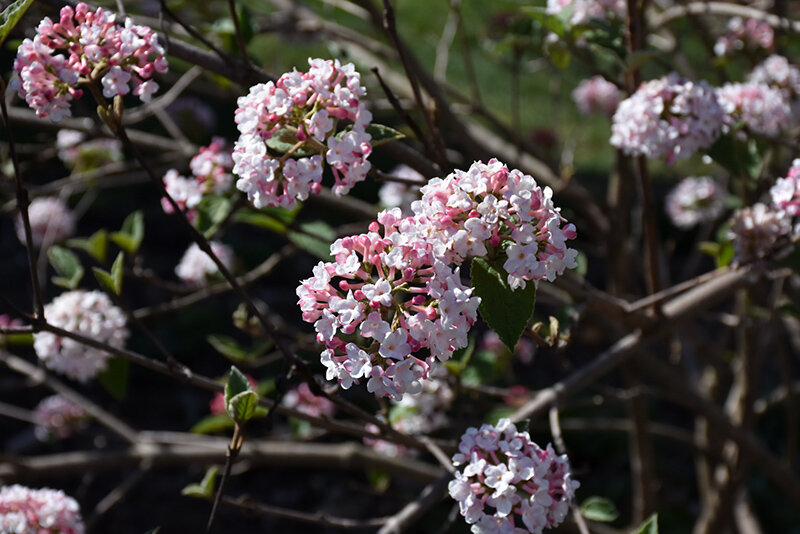Korean spice viburnum (Viburnum carlesii)
Korean spice viburnum (Viburnum carlesii).
Monthly Theme: Is it a scrub, bush or hedge?
Before we get into our featured plant this month, let’s clear up the confusion over scrubs, bushes, and hedges. A shrub is usually taller and has more foliage than a bush. Bushes grow naturally or wild, but shrubs are often pruned and groomed into a desired shape. Technically, they are both woody plants that can grow up to 13’. Since bushes are less manicured, they tend to look like small trees. What about hedges? A hedge is made up of multiple shrubs or bushes (or even trees) grown close together to form a boundary or fence-like structure.
People tend to use all three words interchangeably, but the big difference is how these plants are maintained within any given landscape. In horticulture, a bush would grow upright and look tree-like. A shrub keeps its structure year-round through pruning. Shrubs can be evergreen. It cannot be split or divided because there is only one root base for the plant. A hedge is a highly pruned and used as a border or privacy screen.
Now let’s get back to our featured plant. Drum roll please! Tap, tap, tap, tap, tap… Allow me to introduce one of my favorite shrubs (yes, I refer to this plant as a shrub in my yard), the Korean spice viburnum (Viburnum carlesii). Korean spice viburnum is a deciduous flowering shrub with unbelievably fragrant flowers. In early spring, red-to-pink buds will change to white blossoms with a touch of pale pink. The rounded clustered flowers are incredibly fragrant. If I haven’t mentioned it lately, I adore plants with brilliant aromas and this one tops my list of favorite smells. I planted mine right outside my dining room window so the fragrance wafts throughout my house.
After the bouquet of spring flowers are spent, the plant develops red berries in summer, and the heart-shaped leaves morph from red-wine to purple in the fall. So, if you weren’t sold on the fragrance alone, the Korean spice viburnum looks lovely throughout the seasons. This shrub is about as round as it is high. At maturity, it should reach 6’ tall and 5’ wide. It’s considered a slow-grower (1’-2’ per year), but I enjoy watching plants change year-after-year. In the right conditions, it can live 40 years or more.
If you notice the leaves curling, it might have aphids. Aphids can be controlled with organic neem oil. They won’t kill the shrub, but will make the leaves and general appearance less appealing..
How to Plant
Plant in sun or partial shade.
Plant in the spring
Acid, well-drained soil pH between 5.6-6.6
Smarty Plants Fun Facts
Korean spice viburnum (Viburnum carlesii) belong to Adoxaceae family.
Fertilize in spring with a slow-release tree and shrub fertilizer to support plant health and promote blooms.
To restrict size or maintain shape, prune after they have finished flowering.
Blooms heavily for 3-4 weeks in April-May.
One of the more trouble-free of all shrubs.
The More You Grow
As its name suggests, the Korean spice viburnum is native to parts of Korea as well as Japan. Fortunately, it has been cultivated for over a century for gardens in the West. When it came to the states, some people claim it first arrived in Ohio. Other common names are Korean spicebush and Koreanspice, but it’s all the same plant.
There are several varieties of Korean spice viburnum; i.e., Aurora, Compactum, Spice Bouquet, Spice Island, Sugar N’ Spice (are you catching the whole spice theme?!?), and Burkwood viburnum. I nicknamed my shrub ‘Spice Girl!’ Some varieties grow taller and others shorter. Therefore, you can select a variety that works best for your particular landscape.
I was surprised to learn that the Korean spice viburnum is part of the Elderberry family. Elderberries are a functional and fascinating plant we will need to address in the future. Another interesting fact is the Latin word carlesii refers to William Richard Carles (1848–1929) who was a plant collector in Korea. Hats off to Mister Carles!
In summary, if you are looking for a beautiful accent specimen that doesn’t require hiring a landscape architect to maintain it, I would highly recommend planting a Korean spice viburnum in your yard. Plant it somewhere near an entryway so you can enjoy the aroma. As a bonus, they attract butterflies, wild birds eat the berries, and are generally rabbit and deer-proof.
Happy gardening!
Judith


